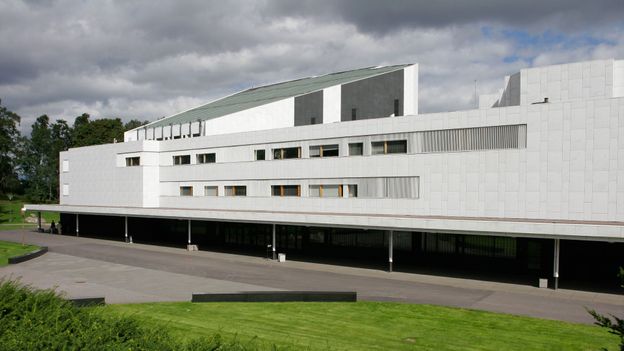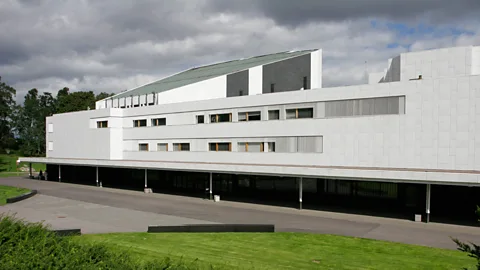
An Alvar Aalto tour of Finland
[ad_1]

The father of Modernism left a legacy of around 400 architectural projects in his home country, the highlights of which can be seen on a tour of southern Finland.
Anyone who has visited an Apple store
will have sat in the sleek High
Stool 64 created by Finnish designer Alvar Aalto. His curvaceous Savoy
vase is still an icon of Finnish design 75 years after its creation. But
these internationally known pieces are not the basis for Aalto’s title as the father
of Modernism. His true claim to fame is his architectural prolificacy, and his
distinctive Nordic Modernist style is on display throughout Finland, his home
country.
During the course of the 20th Century,
Aalto’s Modernist style — defined by the concept of functionalism — changed and matured, resulting in experimentation
with particular materials like his “red brick period” and other styles such as Monumentalism,
which is defined by massive, monumental buildings.
In later years, his inclination for functionalism was often tempered with
elements of humanism, in particular a softening of corners and an abundant use
of wood and other natural materials.
Where Aalto was consistent — and
original — was his devotion to the idea of Gensamkunstwerk (“total work of art”),
where his buildings incorporated many different art forms, including craftsmanship,
interior design and landscape design. He even dabbled in urban planning, lending
his artistic vision to designs of university campuses and city centres.
Over the course of his 55-year
career, Aalto worked on some 500 building projects, about 400 of which are in
Finland. Take a tour around the south of the country to see some of the
highlights.
First stop: Helsinki
The natural starting place for an Alvo Aalto tour is the Helsinki house where
the architect lived and worked for much of his career. Now a museum, the
unassuming Villa Aalto is located in Munkkiniemi, a seaside
neighbourhood that was barely developed when Aalto designed and built the home
in 1935. Containing distinct studio and
living spaces, the home exemplifies the functionalism of Aalto’s early career,
with such practical features as a walk-in closet in the bedroom (unusual at
that time) and a two-sided china cabinet that is accessible from both the
kitchen and the dining room. But the plentiful use of natural materials,
including a dining room wall covered in brown suede, hints at the humanist bend
his designs would take in the coming years.
As Aalto’s career progressed, he needed more room to work, and in 1955
he designed a separate atelier nearby, Studio Aalto (also open for
tours). The curving walls of this white-washed building arc around a courtyard amphitheatre,
a space that was used for client presentations and meetings. Bay windows and skylights
allow for plenty of natural light — ideal for examining documents and
drawings. Every last detail was designed to enhance the aesthetic and work environment.
From Munkkiniemi, head south to Töölö, a central district of Helsinki adjacent
to Töölönlahti Bay and the railway yards. In the early 1960s, Aalto proposed an
extensive city plan for this area, including a series of institutional
buildings that would ring the bay. Only a small part of this plan was ever
realised, namely Finlandia Hall, a concert hall that was completed in 1971. Featured on postage stamps
and the now obsolete 50-Finnmark note, the marble-clad masterpiece reflects
Aalto’s late-career interest in Monumentalism and has become a symbol of
Finland itself. The facade is austere white marble and black granite, with a towering
auditorium rising above the main building. While the visual effect is imposing
and impressive from the outside, the purpose of the auditorium’s high roof was
to enhance the acoustics on the inside (with limited success). Take a guided
tour to see the asymmetrical lines, curving balconies, teak floors and other distinctive
details that personalise his creation.
Second stop: Espoo
Across Laajalahti Bay in the town of Espoo, Aaltar designed the campus of the Helsinki University
of Technology in the 1950s. The red brick
buildings echo classic Ivy League academic architecture — inspired by Aalto’s 1941
stint at the Massachusetts Institute of Technology in Cambridge, Massachusetts.
But Aalto moulded this traditional construction material into his
characteristic curved facades, filling the buildings’ interiors with natural
light and purpose-designed wood furniture. The centrepiece of the campus is a striking
crescent-shaped auditorium, distinguished by terraced windows that descend to
an outdoor amphitheatre. In Aalto’s hand, the staid red brick becomes a conduit
for a progressive, functionalist yet humanist aesthetic. In 2010, the
University of Technology merged with two other schools to form a new,
interdisciplinary institution, named Aalto University to honour the architect’s cultural contributions.
Final stop: Jyväskylä
Located about 280km north of the Finnish capital, the architect’s hometown of
Jyväskylä has more Aalto buildings than any other city in the world. Here, in
the 1950s, he continued his exploration of red-brick construction, especially
on the campus of the University of Jyväskylä and at the Säynätsalo Town Hall.
But Aalto’s most daring use of brick occurred at his
own summer house, the aptly named Experimental House (open for tours June to mid-September) on the island
of Muraatsalo in Jyväskylä.
The L-shaped main building and a separate guest wing enclose three sides of a
courtyard. While the exterior walls are white washed, the inward-facing walls
are comprised of panels of various shapes and sizes — all of them covered with
brick and tile work in various patterns. These walls were a testing ground
where Aalto experimented with different textures, materials and designs,
playing with brick, stone and ceramic swatches and setting them against various
finishes and ornamental plants.
In addition to being a summer home, this was a
laboratory where the architect sought inspiration from nature and tried out new
techniques. In a radical experiment which he called “building without
foundations”, he skipped the concrete substructure and instead built the
guest wing on a pre-existing natural rock formation. This wing was also designated
to experiment with solar heating, an area where Aalto was way ahead of his time.
In the 1960s, Aalto entered his “white period”, when his
work was characterized by buildings with white exteriors and few windows, as exemplified by the Museum
of Central Finland in Jyväskylä, completed in 1961. While the museum is a jumble of
rectangular blocks stacked in seemingly haphazard ways, its defining
characteristic is the plain white facade.
The white period is also on display at the
nearby Alvar Aalto Museum, which the architect completed
a decade later. This rectangular, windowless block grabs attention with its
vertically-aligned tile work — all in white — which creates a rich texture
when it catches the sunlight. The skylights covering the roof provide interior
lighting, as well as additional height inside and out.
The museum’s permanent exhibition is
dedicated to Aalto’s buildings and interior design pieces, as well as his
personal life. More importantly, the building is a venue for temporary exhibitions,
workshops and forums that continue to promote innovation and experimentation in
Finnish design and architecture. In all respects, it is a fitting cap on Aalto’s
long and illustrious career.
[ad_2]
Source link





